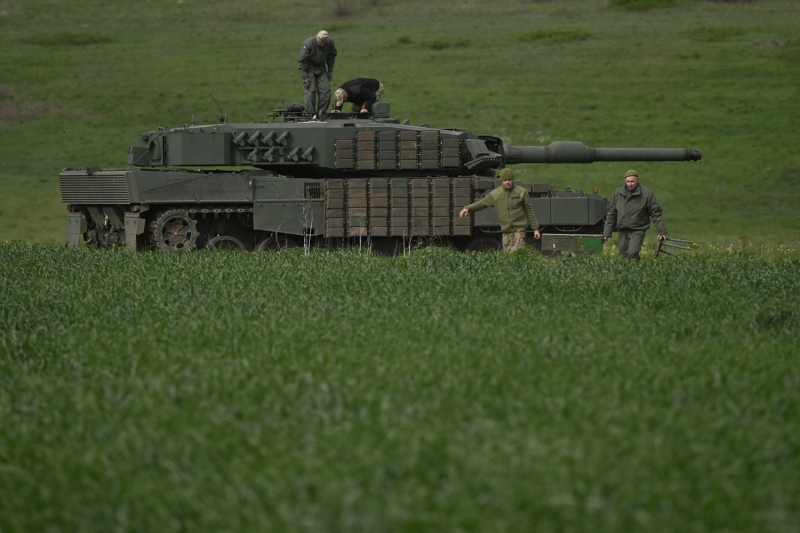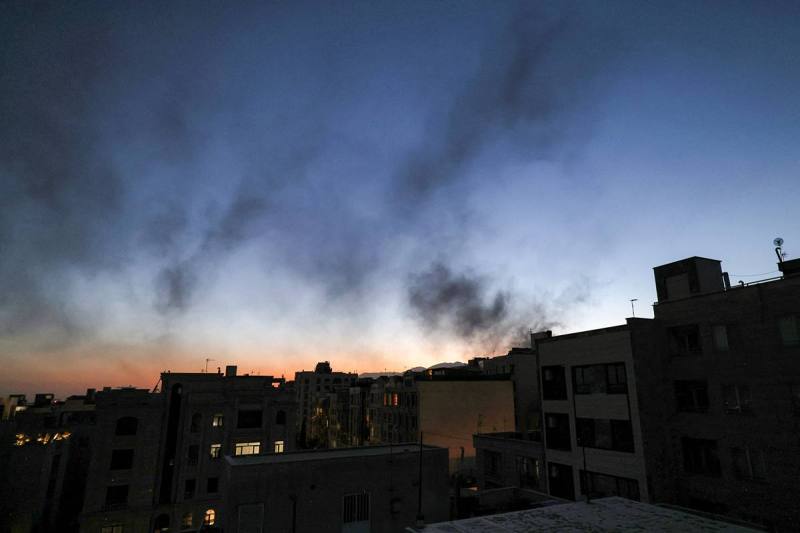Europe Needs to Get Over America

Europe Needs to Get Over America
Europeans must take charge of their own security.
Members of a tank crew of the Ukrainian 33rd Separate Mechanized Brigade take part in a field training exercise with a Leopard 2A4 tank at an undisclosed location in Ukraine on April 30. Genya Savilov/AFP via Getty Images
U.S. President Donald Trump once said he could end the war in Ukraine within 24 hours, something that he now claims was always a joke. More than 100 days into Trump’s second term, Vladimir Putin is behaving as barbarically as ever, if the deadly attacks on Kyiv last week are anything to go by.
On the evidence of the past 100 days—from Trump and his administration threatening to walk away from talks, blaming Ukraine for being invaded, and only mildly criticizing Putin for killing children in Kyiv last week—a credible and meaningful peace deal feels as far away as ever.
U.S. President Donald Trump once said he could end the war in Ukraine within 24 hours, something that he now claims was always a joke. More than 100 days into Trump’s second term, Vladimir Putin is behaving as barbarically as ever, if the deadly attacks on Kyiv last week are anything to go by.
On the evidence of the past 100 days—from Trump and his administration threatening to walk away from talks, blaming Ukraine for being invaded, and only mildly criticizing Putin for killing children in Kyiv last week—a credible and meaningful peace deal feels as far away as ever.
It is time for Europe to start thinking and acting beyond Trump’s America.
The truth is, most European officials agree that Trump simply doesn’t believe that Ukraine (or Europe) is that important to the United States. He certainly doesn’t talk about Europe or Ukraine with the same ferocity as when he talks about Israel and the Middle East, or Asia and China.
Ukraine’s Western allies have been getting their ducks in a row, waiting for white smoke to emerge from the U.S.-led peace talks. The plans of the so-called coalition of the willing—some 31 mostly European countries, led by Britain and France, poised to police any peace deal—are contingent on Trump’s negotiations with Ukraine and Russia producing a credible and meaningful cease-fire.
Even before the 2016 U.S. presidential election, there was an awful lot of conversation on the other side of the Atlantic about “strategic autonomy,” a fancy way of saying that Europe needs to rely less on the United States and build the capabilities to act independently of Washington in geopolitics.
It’s a noble and sensible aim—and if European governments had spent the past eight years actually working together to become sincerely independent of the United States, the situation in Ukraine might look very different.
The full-scale invasion of Ukraine has been a coming of age for many in Europe. The financial, military, and public support for Ukraine has held strong since 2022, much to the surprise of many long-term Europe watchers. But all of that support has, to some extent, played second fiddle to the United States. Now might be the moment for the coalition of the willing—Europe’s chief Russia hawks—to step up, regardless of what’s happening in Trump’s head.
“They need to tune out the noise from Washington. They need to be more proactive and assertive. If they want to develop and deploy a European force to Ukraine, they should get on with it,” said Walter Landgraf, a senior fellow in the Eurasia program at the Foreign Policy Institute, who served in the U.S. military for 20 years.
Landgraf believes that if Europeans were willing to “press on with organizing the expeditionary force and then ask the U.S. to support it with intelligence, logistics, and air defense,” then they could push along the cease-fire process and “help shape the contours of a peace deal.”
He isn’t alone in this view. A recently departed U.S. State Department official, who spoke on the condition of anonymity, said that no matter how much a European peacekeeping force in Ukraine might want the “inflatable floaties” of U.S. logistics support, especially when it comes to activities such as targeting and reconnaissance, it might be time to “jump in the deep end.”
“I think we are at the point where the coalition of the willing might need to start getting on with their plans on the basis that the financial support will be G-7 minus one,” the former official said.
Europe won’t be able to immediately replicate things such as the United States’ intelligence, surveillance, and reconnaissance capacity, air-to-air refueling, and other critical U.S. wraparound support. Immediate plans would need to be made on the assumption that this support will not be available—but could be in the future, if Europe is willing to build it.
In practical terms, that means making commitments to Ukraine right now—whether they involve more equipment or more money—and a medium-term commitment to build the capacity to sustain that support.
What might this look like? Mark Galeotti, a Russia expert and senior associate fellow at the Royal United Services Institute, said that if Europeans and the coalition of the willing want to start getting serious, then they need to make their plans more public and concrete, rather than “hide behind empty mantras and pious but unrealistic demands.”
The “coalition needs to identify potential missions in concrete and practical terms and locate itself within the proposed peace deal,” Galeotti added. “What would they do, with what, and what happens if and when things go wrong. There are all sorts of discussions going on, but it needs to be public if any kind of political mandate can be secured.”
Europe is about to splurge a huge amount of money on defense projects, ranging from procurements to modernizing armies across the continent. The EU’s “Readiness 2030” plan is the most eye-catching example. It earmarks 800 billion euros (roughly $883 billion) of spending that, as the name suggests, will change the face of European security over the next five years.
There is a real opportunity for European governments to join the dots between these spending plans and create a more assertive coalition of the willing. Europe has the opportunity not only to resist Russia now, but also to build something that can sustain future global unrest.
The ambitions of Readiness 2030—a transformed and independent European security structure—are contingent on Ukraine resisting Russia. Replenishing European weapons stocks allows more kit to be sent into Ukraine. Boosting manufacturing inside Ukraine makes it cheaper to provide Ukraine with the equipment to defend itself cheaper, as it removes certain loopholes. It also places European NATO assets inside Ukraine, creating a deterrent inside Ukraine’s borders.
Russia has been handled with kid gloves since Trump took office. The United States might get tougher on Putin at some point. Given that only Trump knows either way, it could be time for Europe to take control of its own destiny and stop worrying what its big cousin in America is doing.
Luke McGee is an Emmy Award-winning journalist covering European diplomacy. He was previously CNN’s European policy editor.
More from Foreign Policy
-

A drawn illustration of a Trump whirlwind on a red background Four Explanatory Models for Trump’s Chaos
It’s clear that the second Trump administration is aiming for change—not inertia—in U.S. foreign policy.
-

Marco Rubio is seen up close, sitting on a couch beside J.D. Vance. Marco Rubio’s Soulless Crusade
The U.S. secretary of state stands for no principle other than serving the man who appointed him.
-

Soldiers from various NATO allies take part in a military exercise at the Smardan Training Area in Smardan, Romania, on Feb. 19. America Will Miss Europe’s Dependence When It’s Gone
European self-reliance for security will cost U.S. jobs, profits, and influence.
-

A collage photo illustration shows Donald Trump gesturing with arms wide. In front of him are headshots of Benjamin Netanyahu and Vlodymyr Zelensky, images of immigratns and ICE police, a tattered EU flag and America First signs. Trump’s First 100 Days on the Global Stage
Ten thinkers on what to make of the opening salvo of the president’s second term.






Join the Conversation
Commenting on this and other recent articles is just one benefit of a Foreign Policy subscription.
Already a subscriber?
.
Subscribe
Subscribe
View Comments
Join the Conversation
Join the conversation on this and other recent Foreign Policy articles when you subscribe now.
Subscribe
Subscribe
Not your account?
View Comments
Join the Conversation
Please follow our comment guidelines, stay on topic, and be civil, courteous, and respectful of others’ beliefs.
Change your username |
Log out
Change your username:
CANCEL
Confirm your username to get started.
The default username below has been generated using the first name and last initial on your FP subscriber account. Usernames may be updated at any time and must not contain inappropriate or offensive language.